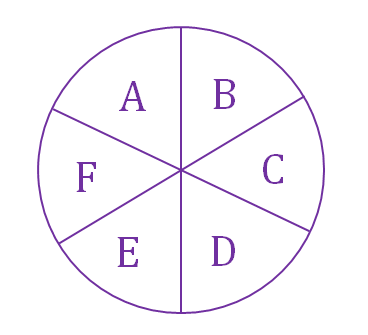Pumpkin Pi
 You baked a nice delicious looking pumpkin
, cut it into 6 slices and served it on your table, as a fan of numbers, you labelled each slice with numbers from 1 to 6.
You baked a nice delicious looking pumpkin
, cut it into 6 slices and served it on your table, as a fan of numbers, you labelled each slice with numbers from 1 to 6.
While still feeling very pleased and satisfied, you went back into your kitchen to grab a glass of water, but once you got back to your table, instead of finding your pumpkin , you found yourself a piece of paper with a pumpkin drawn on it with the labelled numbers replaced by alphabets (as shown above).
Oh no, that's not good news.
You looked at the back of the paper and found a message that reads:
"Harhar... want to get your pumkpin back??? Not until you tell me the numbers labelled on your ."
Bummer, having a terrible memory, you have absolutely no idea how you labelled your .
You continued reading the message:
"Don't worry! Just in case you forget, I had left a liiiiiiitle bit of clue on 6 seperate pieces of paper, but mind you... I'm not always honest..."
Surprisingly, you found 6 pieces of paper under your table, each one reads:
"1---- is adjacent to 4; is adjacent to 3"
"2---- is adjacent to 4; is at the opposite of 6"
"3---- is at the opposite of 4; is adjacent to 5"
"4---- is adjacent to 6; is not adjacent to 5"
"5---- is adjacent to 3; is not adjacent to 6"
"6---- is not at the opposite of 3; is not adjacent to 1"
(If 2 slices are next to each other, then they are adjacent , like A and B, if 2 slices have other 2 slices between them, then they are opposite to each other, like A and D)
Each piece of paper contains 2 information about how your numbers are labelled, and also you know that on every paper, one of the information is true while the other is false.
Can you deduce the numbers labelled on your pumpkin ?
Give your answer by concatenating A, B, C, D, E and F, assuming A is 1, forming a 6-digit number, for example, if you think A, B, C, D, E, F are 1, 2, 4, 3, 5, 6 respectively, then your answer should be 124356. Take note that 124356 and 165342 are technically the same answers except mirrored, give out the number that is smaller , in this case, you should give 124356 as the answer instead of 165342.
The answer is 132546.
This section requires Javascript.
You are seeing this because something didn't load right. We suggest you, (a) try
refreshing the page, (b) enabling javascript if it is disabled on your browser and,
finally, (c)
loading the
non-javascript version of this page
. We're sorry about the hassle.
I made assumptions on whether the truthful information for the first 2 statements, that is, regarding pieces 1 and 2, would be A or B, thus creating 4 hypothesis (which are the combinations of each individual assumption for both statements). I did that because I'd had to test only 4 hypothesis on a, hopefully, much more restrict universe. Turns out that my hope came to be satisfied.
Let's say that H(A,B) is the hypothesis where information A is truthful for statement 1, and information B is truthful for statement 2, so: